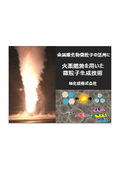Generating metal oxide microparticles such as composite metals and suboxides using synthesis technology with explosives.
Our unique particle generation technology using proprietary explosive combustion enables the production of distinctive fine particles that are difficult to achieve with conventional synthesis techniques! We provide comparison materials for fine particle synthesis methods.
Asahi Kasei Corporation has a synthesis technology for metal nanoparticles using the combustion energy of explosives. This allows for the possibility of generating nanoparticles that are difficult to produce with conventional synthesis methods, such as composite metals of different types and suboxides. If you have any wishes for particles you would like to see, please feel free to consult with us. 【Features】 ■ The high temperature and instantaneous reaction characteristic of explosive combustion enables the generation of unique nanoparticles. ■ Capable of accommodating a variety of materials. ■ The elemental ratios of composite metal oxides can be controlled. ■ Synthesis aimed at suboxides rather than complete oxides is possible. ■ We possess technology to produce spherical particles. ■ It is also possible to shape and provide powders through processes such as compression. *For more details, please refer to the PDF materials or feel free to contact us.
Inquire About This Product
basic information
For more details, please refer to the PDF document or feel free to contact us.
Price range
Delivery Time
Applications/Examples of results
For more details, please refer to the PDF document or feel free to contact us.
catalog(1)
Download All CatalogsCompany information
BA Clad is a clad steel plate manufactured by Asahi Kasei using the explosive welding method, and it has received high praise in various fields since its launch. The explosive welding method utilizes the enormous energy released during an explosion to instantaneously bond metal plates together, thereby producing clad steel plates. BA Clad is used for plants and equipment in the chemical industry, petroleum refining, petrochemicals, and power generation, and is exported widely both domestically and internationally, either as flat plates or various components. It is used as corrosion-resistant and heat-resistant structural materials for power plant condenser tube sheets, heat exchanger tube sheets for chemical plants, shells, and end plates, among others, and its applications are continually expanding to include rolling mill liners, electrodes, ultra-low temperature joints, ultra-high vacuum joints, and structural joints for ships and LNG tankers. We propose solutions related to metal joining (dissimilar metal joining, similar metal joining) and cladding. We can provide joining characteristics such as material properties, joining strength, minimization of alloying at the joining interface, and joining area that are difficult to achieve with other joining methods, such as various welding techniques, diffusion bonding (roll bonding, HIP, etc.), friction joining (friction welding, friction stir welding (FSW)), electromagnetic pressure welding, brazing, plating, and thermal spraying.


